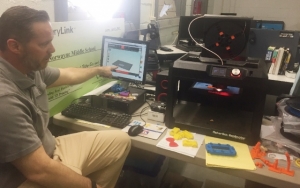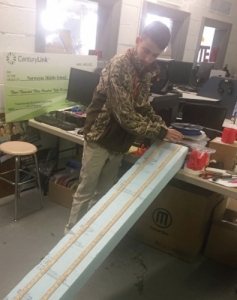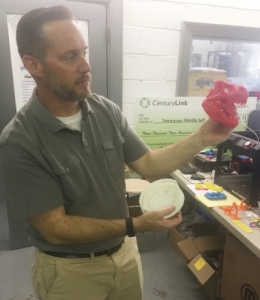Printing a path to learning
By Phyllis Moore
Published in News on February 20, 2017 7:00 AM

News-Argus/PHYLLIS MOORE
Paul Casey, technology education instructor and adviser of the Technology Student Association at Norwayne Middle School, demonstrates the software that connects to the 3-D printer used in his STEM lab at the school.

News-Argus/PHYLLIS MOORE
Norwayne Middle School seventh-grader Luke West demonstrates how a miniature stock car, created in STEM class using a 3-D printer, will be used in a race either in class or one of the competitions students participate in each year.

News-Argus/PHYLLIS MOORE
Paul Casey, technology education instructor at Norwayne Middle School, holds up some of the projects created by his sixth, seventh and eighth-grade students on the 3-D printer in the STEM lab, which centers around science, technology, engineering and math. In addition to the bright red dinosaur shower head and the white model of the Roman Coliseum, other projects have included bookmarks, phone covers and a miniature stock car.
Walking into the STEM lab at Norwayne Middle School, it's difficult to tell who is having more fun -- the teacher or the students.
Paul Casey, technology education instructor there for the past eight years, enthuses about the "new toys" he has acquired since the lab was introduced at the school in 2012.
Golden LEAF Foundation provided a $60,000 grant to refurbish the computer lab classroom to focus on STEM, or science, technology, engineering and math modules. Then about two years ago, Casey wrote a grant that netted him a 3-D printer.
He is also adviser for the TSA, or Technology Student Association, a club that is groomed for competitions -- successfully earning top honors at the state and national levels. This past summer, during the TSA national conference, his students received three Top 10 awards.
Since returning to his alma mater to teach, Casey has had some success of his own, being named 2013-2014 N.C. TSA Adviser of the Year and writing lessons for middle school 3-D printing.
He has involved students in not only the practical, hands-on efforts that come with related class activities, but held fundraisers to support the program. The district rewarded him recently with a smaller 3-D printer, making that the second one in the lab.
"It's just a fun toy to play with for me," he said with a laugh. "Not only do I teach with it in my classroom but in my club. They have used it in two or three different competitions."
The software projects have brought the lessons to life for the students, who have created such things as a dinosaur shower head, bracelets and phone cases, as well as bookmarks, cookie cutters and a miniature stock car.
"For the car, they have to use the dimension of a penny -- around 21 millimeters -- so they can put pennies on them," Casey explained.
Similar to the Cub Scout's popular Pinewood Derby activity, where a race car is carved out of wood and then raced down a track, this version is created from filament that is transformed into hard plastic. The car can be weighted with as many pennies as desired.
"It's a lot like a sewing machine," Casey said of the 3-D printer, likening the colored filament to thread. "They're learning about invention, innovation, prototyping and modeling."
His students are equally excited about the unfolding world of technology they get to explore every day.
Luke West, a seventh-grader, so embraced the concept his parents bought him a 3-D printer for Christmas. It's something he spends time working on "almost every night," he admits, pulling up photos of some of his creations on the computer.
Will he use the technology in the future?
"There's no question about it, is there, Luke?" his teacher asked.
"My family's farmed since 1979, my great-grandaddy started," West said. "I go out there every day working on stuff."
The technology and farming are more connected than one might think, Casey says.
"Farmers are the world's best engineers," he said. "Where they may not have a quick fix but the farm can't wait, they can't leave their crops in the field. It's always been a matter of coming up with a solution."
"If you go to a tractor and there's a problem, all the competition stuff I'm learning here, I can apply it," 13-year-old Luke said.
The program is offered in sixth, seventh and eighth grades, Casey said, and is becoming increasingly popular. The make-up is roughly 60 percent male, 40 percent female.
"My mom is a teacher and one of her students did it and they were telling me how fun it was," said seventh-grader Abigail Wallace. "A lot of my friends were doing it. I like being able to learn new things."
"I signed up for TSA as a fun activity," said her classmate, Courtney Williams. "I decided to take the class because we do a lot of the same things in the club and in the class.
"I think when you get to the competitions, you see all these teams of just boys and there's also girls."
Seventh-grader Karmelo Best has appreciated taking the efforts out on the road -- doing things like designing a car or other product for competitions.
"It's all about team-building," Casey said. "I think a lot of the team-building is a big thing. More and more companies are looking for people that are team players.
"And as far as the careers, I read somewhere that in the next few years 80 percent of the jobs are going to be STEM-related in some way."
As an educator, his role is all about preparing students for the future.
"You don't have to be an engineer to be STEM-related," he said. "You're going to be dealing with STEM no matter what."
Casey said he is paving the way for students to build upon what they are learning at Norwayne, starting with high school. He works closely with Steven Thorne, who leads the Engineering Academy at Charles B. Aycock High School.
"He's an inspiration to me," he said of Thorne, a fellow graduate of CBA. "(The programs) kind of go hand in hand. And he encouraged me to start writing grants."
While Casey hopes he is setting his students up for success, he admits he is also learning from them just as they are learning from him.
"I try to get the kids to understand that as an engineer you fail all the time," he said. "We create a prototype of something. It's not necessarily a failure. It's an opportunity to correct that problem and get closer to the solution.
"I love for them to make mistakes because that's where they learn."
